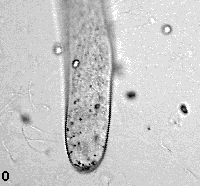
Series of DIC micrographs of a Chara rhizoid first in a normal, vertical
orientation, then turned 90 degrees. Diameter of rhizoid is
about 80
micometers. The numerous dark organelles are statoliths.
Normally,
statoliths are suspended about 30 micrometers above the apex in
an actin
network, but trauma during mounting has caused some statoliths to
fall
from the actin and lie at the extreme apex of the tip.
Images taken 3 s apart. The speed at which the images are
shown
will vary with individual processor; therefore, real time, in seconds,
is
shown in the lower left hand corner. Falling debris in medium
provide a
control to indicate the direction of gravity. To play the sequence
again, hit the "reload"
button on your browser.

0 s Normal vertical
orientation. The detached statoliths are stable, the attached statoliths
moved randomly in their normal central region.
300 s Rhizoid is turned 90 degrees.
500 s Loose statoliths at tip begin to slide
down and basipetally, along the curve of the rhizoid tip
700 s Some movement of the active statoliths
in the central region toward the lower flank is seen.
1300 s The loose statoliths have reached the bottom flank
of the central region, and are swept up into the mass of active statoliths.
1700 s The average statolith position begins to be in the
lower half of the rhizoid, but many are still moving in random directions.
2500 s Most statoliths are in the lower part of the central
region of the rhizoid.